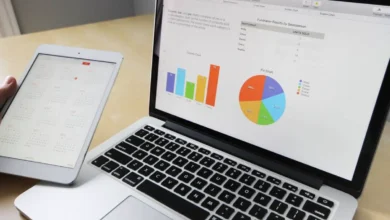Top Digital Marketing Trends in the U.S for 2025
Digital marketing trends in the U.S. for 2025 AI, voice search, micro-influencers & immersive tech shaping the future of customer engagement.

Digital marketing trends in the U.S. for 2025 are shaping up to revolutionize how brands connect with consumers. As technology advances at a rapid pace, marketers must adapt to emerging innovations from AI-powered personalization to immersive metaverse experiences. The Digital Marketing is becoming more interactive, privacy-focused, and customer-centric, requiring businesses to rethink their strategies to stay competitive. Those who embrace these evolving trends early will gain a significant advantage in engagement, conversions, and brand loyalty.
The coming year will see a stronger emphasis on hyper-targeted campaigns, ethical data practices, and next-generation technologies like voice search and augmented reality. Consumer expectations are higher than ever, with demand for seamless, personalized, and value-driven interactions. They explores the most impactful digital marketing trends in the U.S. for 2025, providing actionable insights to help businesses navigate the future of Digital Marketing engagement successfully.
Top Digital Marketing Trends in the U.S for 2025
The Rise of AI and Hyper-Personalization
Artificial Intelligence (AI) is no longer a futuristic concept it’s a core component of modern digital marketing. By 2025, AI-powered tools will enable hyper-personalized customer experiences, from dynamic content recommendations to predictive analytics. Machine learning algorithms analyze vast amounts of data to deliver tailored messaging, ensuring higher engagement and conversion rates. Chatbots and virtual assistants will become even more sophisticated, handling complex customer queries seamlessly. Businesses that integrate AI into their marketing strategies will benefit from increased efficiency and deeper consumer insights.
Voice Search Optimization Takes Center Stage
With the growing popularity of smart speakers and voice assistants like Alexa and Google Assistant, voice search optimization is crucial for brands. By 2025, over 50% of all searches in the U.S. are expected to be voice-based. Marketers must optimize their content for conversational queries, focusing on long-tail keywords and natural language processing. Local SEO will also play a significant role, as many voice searches are location-specific. Companies that fail to adapt risk losing visibility in an increasingly voice-driven search landscape.
Privacy-Centric Marketing Gains Importance
As data privacy regulations tighten, consumers are becoming more cautious about sharing personal information. Marketers must prioritize transparency and consent-based strategies to build trust. Zero-party data information willingly shared by users will be invaluable for personalization without violating privacy norms. Businesses that adopt ethical data practices and comply with regulations like GDPR and CCPA will foster stronger customer relationships while avoiding legal pitfalls.
Video Marketing Continues to Dominate
Video content remains one of the most effective digital marketing tools, and its influence will only grow in 2025. Short-form videos (like TikTok and Instagram Reels) and live streaming will dominate social media platforms. Interactive videos with shoppable links and personalized recommendations will enhance user engagement. Brands that invest in high-quality, platform-specific video content will capture audience attention more effectively than those relying solely on static ads.
Sustainability and Purpose-Driven Marketing
Modern consumers prefer brands that align with their values, particularly regarding sustainability and social responsibility. In 2025, purpose-driven marketing will be a key differentiator. Companies must communicate their environmental and social initiatives authentically to resonate with eco-conscious audiences. Green marketing strategies, such as promoting sustainable products and carbon-neutral practices, will attract loyal customers who prioritize ethical consumption.
Augmented Reality (AR) and Virtual Reality (VR) Enhance Customer Engagement
AR and Virtual Reality technologies are transforming digital marketing by offering immersive brand experiences. In 2025, more businesses will leverage AR for virtual try-ons, interactive ads, and 3D product demonstrations. VR, on the other hand, will be used for virtual showrooms and experiential marketing campaigns. These technologies bridge the gap between online and offline shopping, boosting customer confidence and reducing return rates. Brands that invest in AR/VR early will gain a competitive edge in customer engagement.
The Growing Influence of Micro and Nano-Influencers
Redefining Authenticity in Digital Marketing
The influencer marketing landscape is undergoing a significant shift as brands increasingly recognize the value of micro (10K-100K followers) and nano-influencers (1K-10K followers). Unlike celebrity influencers with massive but often disengaged audiences, these smaller content creators boast highly dedicated niche communities. Their followers view them as relatable peers rather than distant personalities, resulting in 60% higher engagement rates according to recent studies.
The Power of Hyper-Targeted Audience Reach
Micro and nano-influencers dominate specific interest verticals with surgical precision, whether it’s sustainable fashion, indie beauty brands, or niche tech gadgets. A nano-influencer in the vegan skincare space, for example, often maintains a more active and responsive following than a general lifestyle influencer with 500K followers. Platforms like TikTok and Instagram Reels have amplified this effect through algorithm-driven content discovery, where authentic micro-influencers frequently outperform larger accounts in organic reach.
Cost-Effectiveness and Higher ROI
With celebrity influencers commanding five-figure sponsorship fees per post, smaller creators offer accessible entry points for brands with limited budgets. Nano-influencers typically collaborate for product exchanges or modest fees, while delivering comparable (if not superior) engagement metrics. This democratization has led to the rise of performance-based partnerships, where influencers earn commissions through affiliate links or sales-driven bonuses.
From Promotion to Community Building
A striking 82% of consumers trust recommendations from micro-influencers over traditional ads (Nielsen). This stems from their transparent, unfiltered content style think unpolished “day in the life” stories or honest product reviews. Unlike heavily produced celebrity posts, nano-influencers often use casual smartphone footage, fostering a sense of raw authenticity. Forward-thinking brands are leveraging this by co-creating content with micro-influencers, turning them into long-term ambassadors rather than one-off promoters.
Platforms Fueling the Micro-Influencer Boom
While Instagram remains a hub for influencer marketing, emerging platforms are accelerating this trend. BeReal’s spontaneous content model rewards authenticity, while Lemon8’s hybrid Pinterest-TikTok format thrives on niche micro-influencers. Even LinkedIn is joining the movement, with B2B brands collaborating with industry-specific nano-influencers for thought leadership. Notably, TikTok’s “Spark Ads” now let brands amplify organic micro-influencer posts as paid ads blurring the line between organic and sponsored content while maintaining credibility.
Micro-Influencers as Community Leaders
Looking ahead to 2025, we’ll see micro and nano-influencers evolve into full-fledged community architects. Brands will empower them with exclusive product development input (e.g., ColourPop’s influencer-designed palettes) or even revenue-sharing models. Tools like Shopify’s “Collaborator” portals are making it easier to manage hundreds of micro-influencer relationships at scale.
Read More: Must-Have Gadgets for Tech Enthusiasts in the U.S.
Conclusion
Digital marketing trends in the U.S. for 2025 present both exciting opportunities and new challenges for brands looking to stay ahead in an increasingly competitive digital landscape. As AI, voice search, immersive technologies, and privacy-focused strategies reshape Digital Marketing approaches, businesses must remain agile and customer-centric to succeed. The brands that will thrive are those that leverage these innovations not just to sell, but to create genuine value, build trust, and deliver seamless experiences across every touchpoint.
Looking ahead, the key to success lies in balancing cutting-edge technology with authentic human connection. While digital marketing trends in the U.S. for 2025 emphasize automation and data-driven strategies, the most impactful campaigns will still center on storytelling, emotional engagement, and meaningful consumer relationships. By staying informed, adaptable, and committed to ethical marketing practices, businesses can turn these emerging trends into powerful tools for sustainable growth in the years to come.
FAQs
What is the biggest digital marketing trend for 2025?
AI-driven personalization will be the most significant trend, enabling hyper-targeted customer experiences through data analysis and automation.
How important is voice search optimization?
Extremely important over 50% of searches will be voice-based by 2025, requiring brands to optimize for conversational queries.
Why should businesses invest in AR/VR marketing?
AR/VR enhances engagement by offering immersive experiences, reducing return rates, and bridging online-offline shopping gaps.
How can brands ensure privacy-compliant Digital Marketing?
By adopting zero-party data strategies, being transparent with users, and complying with regulations like GDPR and CCPA.
Are micro-influencers more effective than celebrities?
Yes, micro-influencers often drive higher engagement and trust due to their niche, loyal audiences.











